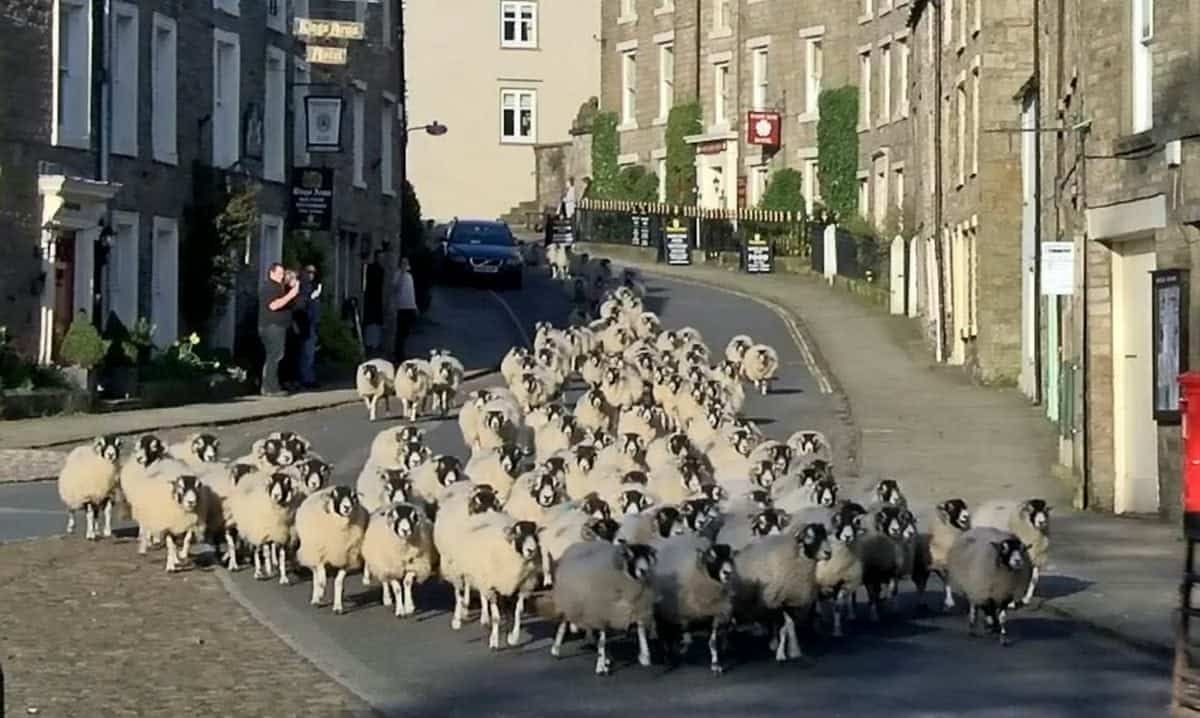
This baaaaa-rmy footage shows a parade of 200 ewes trotting from the top of a tiny village to lamb in a field below in a 90-year-old tradition that marks the start of spring. See Ross Parry story RPYSHEEP; The pregnant sheep on Hodgson's farm in Askrigg in the Yorkshire Dales make the two mile journey downhill over five days every year to move to a safe sheltered field to give birth to their lambs. The journey through the steep village, which has a population of just 550, in North Yorks., is made in three stages to give the ewes, who are ready to drop, ample rest during their relocation. The move causes such a spectacle that locals and tourists in the village, made famous by the 80s TV show All Creatures Great and Small, flock to the streets to watch the procession. Farmer's wife, Heather Hodgson, 45, told how the whole family get in on the act with eldest daughter Chloe, 6, heading the herd by opening up the gates. Chloe even dressed especially for the occasion are wore her Elsa dress, from the film Frozen. Next in line is father-in-law, David Hodgson, 69, who runs the farm with Heather's husband, James, 43, driving the tractor carrying son, Ro, 11, who was throwing ewe nuts to the sheep to encourage them to follow. Bringing up the rear was farmer James, Heather, their youngest daughter, Jo, 4, and their sheepdog, Max, 8.
This baaaaa-rmy footage shows a parade of 200 ewes trotting from the top of a tiny village to lamb in a field below in a 90-year-old tradition that marks the start of spring.
The pregnant sheep on Hodgson’s farm in Askrigg in the Yorkshire Dales make the two mile journey downhill over five days every year to move to a safe sheltered field to give birth to their lambs.
The journey through the steep village, which has a population of just 550, in North Yorks., is made in three stages to give the ewes, who are ready to drop, ample rest during their relocation.
The move causes such a spectacle that locals and tourists in the village, made famous by the 80s TV show All Creatures Great and Small, flock to the streets to watch the procession.
Farmer’s wife, Heather Hodgson, 45, told how the whole family get in on the act with eldest daughter Chloe, 6, heading the herd by opening up the gates.
Chloe even dressed especially for the occasion are wore her Elsa dress, from the film Frozen.
Next in line is father-in-law, David Hodgson, 69, who runs the farm with Heather’s husband, James, 43, driving the tractor carrying son, Ro, 11, who was throwing ewe nuts to the sheepto encourage them to follow.
Bringing up the rear was farmer James, Heather, their youngest daughter, Jo, 4, and their sheepdog, Max, 8.
James gives instructions with whistles and shouts to keep the sheep in line, making sure their are no ewe-turns.
Heather said: “The Hodgson family have owned this farm for four generations and this tradition started when the farm began in 1926.
“Our sheep are kept in a field up at the top of the field but it is a bit too exposed for the ewes to lamb, so at this time every year we bring the sheep down to the field at the bottom, where it’s a bit warmer.
“The sheep are heavily pregnant and can’t do the journey in one go, so they have to make two stops in fields on the way down – stopping in each field for a couple of nights a time – so they have enough energy to make it.
“Just like mums, you can often find that the vigorous journey has set some of the sheep off and they’ll have their lambs as soon as they get there.”
The family own around 350 sheep, but the males are left at the top of the hill – just the pregnant females are brought down.
All of the sheep on the journey are expecting twins or single lambs.
Heather said: “Just like us, you find the multiple births come sooner.
“The twins will come next and then the singles.”
Once the sheep have been delivered farmer James attends to the sheep every two hours through the days and nights to tend to the lambs.
Heather said: “James doesn’t have to do that much work. The sheep can manage to give birth themselves but he has to keep an eye on them and check they are okay.”
Once the sheep give birth they will slowly be taken back up the hill in separate groups.
“The ride back uphill is not such a big deal, we’ll get them back up by transporting a few at a time on the back of the trailer.
“They will all be back up there by the end of May.”